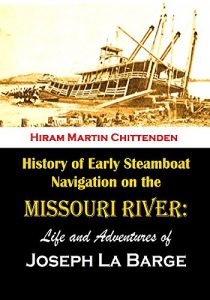No less authority than Hiram Chittenden wrote this marvelous history of the early days of one of America's most important waterways. A West Point engineer, namesake of the Hiram Chittenden locks in Seattle, Chittenden was a respected historian of early western America.
There was no railroad system in the United States whose importance to its tributary country was relatively greater than was that of the Missouri River to the trans-Mississippi territory in the first seventy-five years of the nineteenth century.
Through the earliest days of navigation on the great Missouri, through its use in the Civil War, the Indian Wars, Custer's Last Stand, and its eventual demise as a major highway due to the development of the railroads, this history tells of an America that depended on rivers for expansion. Though Grant Marsh captained the steamer Far West, which took the wounded Little Bighorn survivors to Ft. Lincoln, La Barge also saw service as a captain on Custer's Yellowstone Expedition.
The life of Joseph La Barge exemplifies the 19th century life of the river. The author met La Barge shortly before his death and found him to be an extraordinary wealth of information about early steamboat travel, as La Barge had owned and operated boats on the river for many years. He was on the first boat that went to the far upper river, and he made the last through voyage from St. Louis to Fort Benton.
CHAPTER I.
Ancestry Of Captain La Barge
CHAPTER II.
Childhood And Youth
CHAPTER III.
Enters The Fur Trade
CHAPTER IV.
Cholera On The Yellowstone
CHAPTER V.
Further Service At Cabanne's
CHAPTER VI.
Last Year At Cabanne's
CHAPTER VII.
Captain La Barge In opposition
CHAPTER VIII.
The Missouri River
CHAPTER IX.
Kinds Of Boats Used On The Missouri
CHAPTER X.
Steamboat Navigation On The Missouri River
CHAPTER XI.
The Steamboat In The Fur Trade
CHAPTER XII.
Voyage Of 1843
CHAPTER XIII.
Voyage Of 1844
CHAPTER XIV.
Changed Conditions
CHAPTER XV.
Incidents On The River (1845-50)
CHAPTER XVI.
Incidents On The River (1851-53)
CHAPTER XVII.
Ice Break-up or 1856
CHAPTER XVIII.
The Head Of Navigation Reached
CHAPTER XIX.
Fort Benton
CHAPTER XX.
Abraham Lincoln On The Missouri
CHAPTER XXI.
The Civil War
CHAPTER XXII.
Gold In Montana
CHAPTER XXIII.
Incidents On The River (1862-67)
CHAPTER XXIV.
La Barge Again In Opposition
CHAPTER XXV.
Voyage Of 1863—The Tobacco Garden Massacre
CHAPTER XXVI.
The Blackfoot Annuities
CHAPTER XXVII.
Collapse Of The La Barge-harkness Opposition
CHAPTER XXVIII.
Captain La Barge In Montana
CHAPTER XXIX.
Captain La Barge In Washington
CHAPTER XXX.
The Indian Of The Missouri Valley
CHAPTER XXXI.
The Army On The Missouri
CHAPTER XXXII.
The Steamboat In The Indian Wars
CHAPTER XXXIII.
The Peace Commission Of 1856
CHAPTER XXXIV.
The Murder Of Captain Speak
CHAPTER XXXV.
The Battle With The Railroads
CHAPTER XXXVI.
Last Voyages To Benton
CHAPTER XXXVII.
Declining Years
CHAPTER XXXVIII
Destiny Of The Missouri River
This book published in 1903 has been reformatted for the Kindle and may contain an occasional defect from the original publication or from the reformatting.
There was no railroad system in the United States whose importance to its tributary country was relatively greater than was that of the Missouri River to the trans-Mississippi territory in the first seventy-five years of the nineteenth century.
Through the earliest days of navigation on the great Missouri, through its use in the Civil War, the Indian Wars, Custer's Last Stand, and its eventual demise as a major highway due to the development of the railroads, this history tells of an America that depended on rivers for expansion. Though Grant Marsh captained the steamer Far West, which took the wounded Little Bighorn survivors to Ft. Lincoln, La Barge also saw service as a captain on Custer's Yellowstone Expedition.
The life of Joseph La Barge exemplifies the 19th century life of the river. The author met La Barge shortly before his death and found him to be an extraordinary wealth of information about early steamboat travel, as La Barge had owned and operated boats on the river for many years. He was on the first boat that went to the far upper river, and he made the last through voyage from St. Louis to Fort Benton.
CHAPTER I.
Ancestry Of Captain La Barge
CHAPTER II.
Childhood And Youth
CHAPTER III.
Enters The Fur Trade
CHAPTER IV.
Cholera On The Yellowstone
CHAPTER V.
Further Service At Cabanne's
CHAPTER VI.
Last Year At Cabanne's
CHAPTER VII.
Captain La Barge In opposition
CHAPTER VIII.
The Missouri River
CHAPTER IX.
Kinds Of Boats Used On The Missouri
CHAPTER X.
Steamboat Navigation On The Missouri River
CHAPTER XI.
The Steamboat In The Fur Trade
CHAPTER XII.
Voyage Of 1843
CHAPTER XIII.
Voyage Of 1844
CHAPTER XIV.
Changed Conditions
CHAPTER XV.
Incidents On The River (1845-50)
CHAPTER XVI.
Incidents On The River (1851-53)
CHAPTER XVII.
Ice Break-up or 1856
CHAPTER XVIII.
The Head Of Navigation Reached
CHAPTER XIX.
Fort Benton
CHAPTER XX.
Abraham Lincoln On The Missouri
CHAPTER XXI.
The Civil War
CHAPTER XXII.
Gold In Montana
CHAPTER XXIII.
Incidents On The River (1862-67)
CHAPTER XXIV.
La Barge Again In Opposition
CHAPTER XXV.
Voyage Of 1863—The Tobacco Garden Massacre
CHAPTER XXVI.
The Blackfoot Annuities
CHAPTER XXVII.
Collapse Of The La Barge-harkness Opposition
CHAPTER XXVIII.
Captain La Barge In Montana
CHAPTER XXIX.
Captain La Barge In Washington
CHAPTER XXX.
The Indian Of The Missouri Valley
CHAPTER XXXI.
The Army On The Missouri
CHAPTER XXXII.
The Steamboat In The Indian Wars
CHAPTER XXXIII.
The Peace Commission Of 1856
CHAPTER XXXIV.
The Murder Of Captain Speak
CHAPTER XXXV.
The Battle With The Railroads
CHAPTER XXXVI.
Last Voyages To Benton
CHAPTER XXXVII.
Declining Years
CHAPTER XXXVIII
Destiny Of The Missouri River
This book published in 1903 has been reformatted for the Kindle and may contain an occasional defect from the original publication or from the reformatting.






